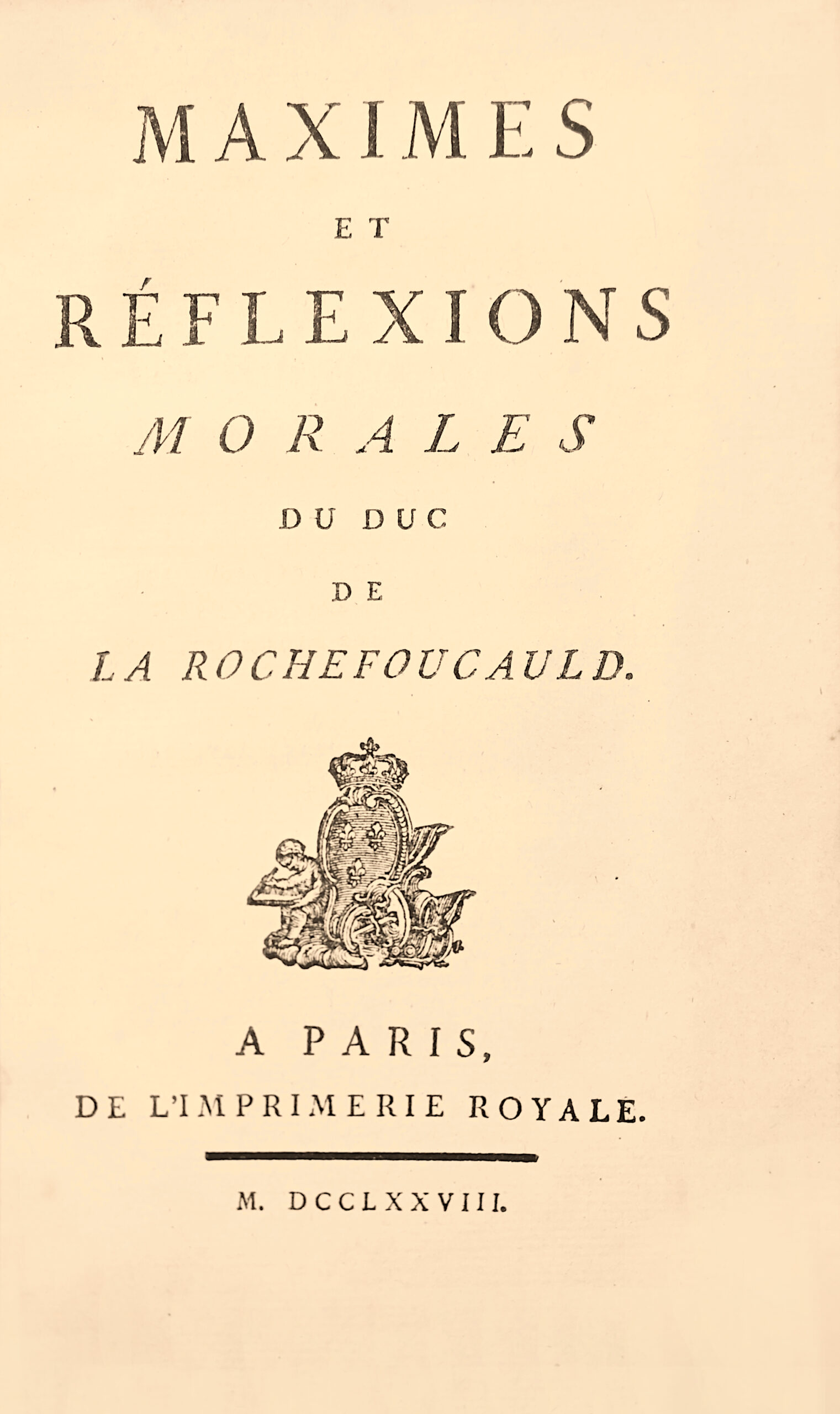A Paris, de l’imprimerie royale, 1778.
8vo of xxiv pp., 154 pp., xiv pp., full red morocco, triple gilt fillet around the covers, arms in the center, flat spine decorated with armorial pieces, green morocco lettering-piece, inner border, gilt adges. Contemporary binding.
181 x 114 mm.
First edition of La Rochefoucauld’s Maximes issued from the royal printer’s presses “printed in a small number, not put on the market and reserved for friendly philosophers” according to Tchemerzine.
“According to the Avertissement, this edition was based on the original manuscript and on copies corrected by the author. It also states, contrary to Brunet’s assertion, that “only a small number of copies were printed, for the philosophes amis, and none were sold“. (Tchemerzine, IV, 49).
The publisher’s Foreword reveals the genesis of the edition: “Les Réflexions morales de M. le Duc de la Rochefoucauld were first printed in 1665. In ten years, five successive editions have been published, with considerable additions and changes, directed by the Author himself. Since then, editions have multiplied; but never has a work been more mistreated by its publishers. They have disfigured the text through typographical negligence of every kind; they have inverted the order that the Author had given to the thoughts, under the pretext of putting in one that the nature of the work is not susceptible to; they have attached, for some reason, to the “Moral Maxims” of M. de La Rochefoucauld, the “Christian Maxims” of Madame de la Sablière; they have drowned the one & the other in a host of useless notes, most of them puerile & sometimes ridiculous. This new edition is based on M. de la Rochefoucauld’s original manuscript & on copies of the first editions, corrected by his own hand. We have restored a large number of thoughts omitted or ignored by previous editors: we have re-established the order that the Author had deemed appropriate to give them, and we have made up for the lack of connection that is found there by an exact & convenient table. The text has been corrected in a large number of places; it has been purged of all the superfluities with which it had been overloaded by the zeal of the Commentators & the greed of the Booksellers. Finally, nothing has been neglected to make this edition more complete, more correct, more worthy of the work’s fame & the public’s attention”.
From the moment of its publication, this work was a success, in which scandal played a major role. Voltaire wrote: “This little collection was quickly read; it accustomed people to think and to enclose their thoughts in a lively, precise and delicate tone. It was a merit that no one had had before him, in Europe, since the Renaissance of letters”.
“The author assiduously frequented the salons of the time, those of Mlle de Scudéry, Mlle de Montpensier and Madame de Sablé. It was at the latter, especially from 1659 onwards, that La Rochefoucauld met the Abbé Esprit, the Abbé d’Ailly, the jurisconsult Domat, the Maréchale de Schomberg, the Duchesse de Longueville and the Montausiers. If the grande Mademoiselle was all about “portraits”, Madame de Sablé was all about “maxims”. Someone would propose an opinion on a moral issue, and the regulars would discuss it. At home, between two sessions, we tried to put our feelings on the subject in writing, giving it a lively, piquant twist. Everyone got involved. The best was then collected. After La Rochefoucauld’s “Maximes” came the “Maximes” of Madame la marquise de Sablé, published by Abbé d’Ailly, who added his own, and those of Abbé Esprit, Domat, Méré and others. But, in this small group, it was La Rochefoucauld who most often acted as “greffier”; so, before publishing his collection, he consulted his friends on these “Maximes” in which they had had so much part.”
A precious copy cited by Olivier printed on large Holland paper bound in contemporary red morocco with the arms of Louis-Auguste de Rohan-Chabot.
Louis-Antoine-Auguste de Rohan-Chabot, known as le comte de Chabot, comte de Maillé la Marche, then duc de Chabot, eldest son of Guy-Auguste, lieutenant general, and Yvonne-Sylvie du Breil de Rais, his first wife, born on April 20, 1733, became colonel of the Royal-Etranger cavalry regiment, cavalry brigadier in December 1761, maréchal de camp in June 1763 and lieutenant general; He was created Chevalier du Saint-Esprit on June 8, 1783. He died in Paris on December 13, 1786. He had married Elisabeth Louise de La Rochefoucauld on April 12, 1757.
Tool stamped on: « Maximes et réflexions morales du duc de La Rochefoucauld ». Paris, imp. Royale, 1778. (Librairie Ch. Bosse). Olivier, plate 2037.
Copy similar to the one sold 275 000 FF (42 000 €) in 1989, 35 years ago by Pierre Berès (Ref. Cat. 79, n°79).


